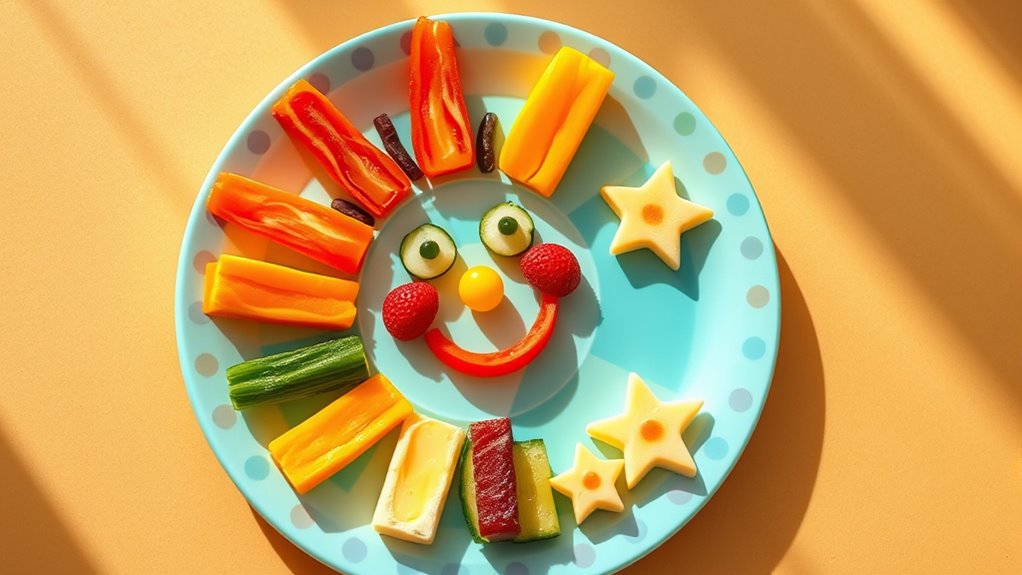To encourage a balanced diet in picky toddlers, create a fun, colorful mealtime environment by offering vibrant foods and arranging them creatively. Involve your child in choosing and preparing meals, establishing consistent routines while respecting their hunger cues. Gradually introduce new foods with patience, using playful presentations to spark interest. Celebrate small successes to boost their confidence. Keep exploring these tips to discover how to turn mealtime into a positive, healthy experience they’ll enjoy.
Key Takeaways
- Offer a variety of colorful, visually appealing foods to attract interest and expose toddlers to diverse nutrients.
- Involve children in meal planning and preparation to boost independence and willingness to try new foods.
- Introduce new foods gradually with fun presentation and repeated gentle exposure to build acceptance.
- Use positive reinforcement and specific praise to encourage adventurous eating and boost confidence.
- Establish consistent routines and create a calm, stress-free mealtime environment to promote healthy eating habits.
Offer a Variety of Colorful Foods to Spark Interest

Offering a variety of colorful foods can make mealtime more appealing and encourage your toddler to try new flavors. Bright, vibrant plates catch their eye and stimulate curiosity. Fill their plate with colorful vegetables like red bell peppers, orange carrots, green peas, and purple cauliflower. Pair these with a fruit variety such as strawberries, blueberries, mango slices, and kiwi. The range of colors not only makes the meal visually interesting but also exposes your toddler to different nutrients. When foods look lively and inviting, your little one is more likely to take an interest in eating them. Incorporating visual appeal into meals can significantly boost your child’s willingness to explore new foods. Additionally, offering a variety of textures can enhance sensory development and make eating more engaging. Keep offering a spectrum of hues, and over time, your child will develop a taste for diverse, healthy options. This simple trick makes mealtime both fun and nutritious.
Make Mealtime a Pleasant and Stress-Free Experience

Creating a calm atmosphere during mealtime helps your toddler feel relaxed and willing to try new foods. Establishing consistent routines makes mealtime predictable and reduces stress for both of you. When you set a positive tone, dining becomes a pleasant experience that encourages healthy eating habits.
Set a Calm Atmosphere
A calm mealtime environment helps toddlers develop healthy eating habits and reduces mealtime stress. Creating a peaceful, child-focused atmosphere encourages positive associations with eating and minimizes distractions. Keep noise levels low, turn off screens, and use gentle tones to foster relaxation. Setting this tone helps your child feel safe and valued during meals. To make it easier, consider this simple table:
| Aspect | Tip | Benefit |
|---|---|---|
| Mealtime environment | Minimize distractions | Focus on eating and bonding |
| Child-focused atmosphere | Engage calmly and patiently | Boosts comfort and trust |
| Overall setting | Keep it cozy and inviting | Promotes relaxed, enjoyable meals |
Implementing these strategies creates a positive mealtime experience that encourages your toddler to try new foods and develop healthy habits naturally. Additionally, choosing the right projector technology can enhance family movie nights, making them more engaging and visually appealing. Incorporating mealtime routines can further reinforce good eating habits and create consistency for your child. Being aware of Gold IRA rollover options can also provide long-term financial benefits for your family’s future. Incorporating natural techniques such as offering a variety of vegetable juices can also make meals more appealing and nutritious for your little one.
Establish Consistent Routines
Establishing consistent routines around mealtime helps your toddler feel secure and know what to expect, making eating times more enjoyable and less stressful. When you stick to regular mealtime schedules, your child begins to understand that mealtimes happen at certain times each day, promoting mealtime consistency. This predictability reduces anxiety and encourages healthy eating habits. Routine reinforcement, such as setting the table together or having a calming pre-meal activity, helps your toddler associate these cues with eating. Keep mealtime routines simple and positive, avoiding distractions like screens. Over time, your child will anticipate mealtimes with confidence, making it easier to introduce new foods and develop balanced eating habits. Consistent routines create a supportive environment where your toddler feels secure and ready to eat. Empowering families through predictable routines helps build a foundation of trust and confidence during early parenthood. Incorporating healthy beverage options like no-sugar-added drinks can also make mealtime more appealing and nutritious. Additionally, choosing modern toilets with features like dual-flush systems can help conserve resources during busy family routines. Consistent routines also aid in managing affiliate disclosures, ensuring transparency about product recommendations during meal planning or shopping.
Involve Your Toddler in Meal Planning and Preparation

Getting your toddler involved in meal planning and prep gives them a sense of control and ownership. Letting them choose between healthy options and helping with simple tasks makes mealtime more enjoyable. This hands-on experience encourages them to try new foods and develop good eating habits. Incorporating small, fun skincare routines can also boost their interest in healthy habits. Additionally, creating a calm and inviting mealtime environment can make your child more receptive to trying new foods and enjoying family meals. Engaging children in age-appropriate food preparation not only teaches them valuable skills but also fosters positive attitudes toward eating. Incorporating positive reinforcement during meals can further motivate children to accept new foods and develop healthier eating patterns. Using approachable and nutrient-dense foods can help ensure they receive essential vitamins and minerals while enjoying their meals.
Choice Empowers Kids
When you involve your toddler in meal planning and preparation, you give them a sense of ownership over their food choices. This boosts their mealtime independence and encourages food choice autonomy. When kids feel they have a say, they’re more likely to be open to trying new foods and eating balanced meals. Let them pick between two healthy options or help wash vegetables. Giving them small responsibilities makes mealtime more positive and less stressful. It also helps them learn about different foods and develop confidence in making decisions about what they eat. Incorporating proper preparation techniques into their involvement can further enhance their understanding and appreciation of healthy eating. Engaging children in safe food handling teaches important skills and promotes their trust in the kitchen. Recognizing the role of AI in education can help develop innovative tools to support healthy eating habits. Additionally, fostering an environment of positive mealtime experiences can make mealtimes more enjoyable and reinforce healthy choices. Moreover, providing clear explanations about food benefits can foster a greater interest in nutritious choices. By empowering your toddler in this way, you foster a sense of control that can reduce picky eating and promote healthier eating habits overall.
Hands-On Experience
Involving your toddler in meal planning and preparation gives them hands-on experience that builds their interest and confidence in healthy eating. Let them help with simple tasks like washing vegetables or stirring ingredients, introducing basic cooking techniques. This active participation engages their senses through sensory play, making the experience enjoyable and memorable. As they touch, smell, and see different textures and colors, they become more curious about the foods they’re helping prepare. Encourage them to choose a vegetable or fruit to include in the meal, giving them a sense of ownership. Additionally, fetal movements can be felt around 18-20 weeks during pregnancy, which can reassure expectant mothers of fetal development. By involving your toddler in these practical activities, you foster positive associations with healthy foods and lay the foundation for balanced eating habits that can last a lifetime.
Establish Consistent Meal and Snack Times
Establishing consistent meal and snack times helps your toddler develop healthy eating habits and creates a predictable routine they can rely on. A steady mealtime routine sets clear expectations, reducing fussiness and hunger-induced tantrums. By sticking to a regular snack schedule, you help prevent excessive snacking and ensure your child feels full and satisfied during main meals. Consistency also helps regulate your toddler’s digestion and energy levels throughout the day. Make sure to serve meals and snacks at roughly the same times each day, creating a sense of stability. Keep in mind that toddlers thrive on routine, so maintaining a predictable schedule helps them feel secure and encourages better eating habits over time.
Introduce New Foods Gradually and Persistently

Start by offering small portions of new foods alongside familiar favorites to make the shift easier. Use fun presentations to catch your toddler’s interest and encourage tasting. Remember to be patient and persistent, as repeated gentle exposure helps build their willingness to try new things.
Offer Small Portions Regularly
Offering small portions of food regularly can make a big difference in a toddler’s eating habits. This approach helps with portion control and prevents overwhelming them. Keep in mind, snack frequency matters—offer nutritious snacks between meals to maintain energy without overfilling their small stomachs. Consistency is key; serve the same small portions at regular intervals to build familiarity and trust in new foods. Use the table below to plan your routine:
| Meal Timing | Snack Options |
|---|---|
| Breakfast | Fruit slices, yogurt |
| Lunch | Veggie sticks, cheese |
| Snack | Crackers, nuts |
| Dinner | Small portions of protein and veggies |
Use Fun Food Presentations
Introducing new foods to toddlers can be challenging, but using fun and appealing food presentations makes the process easier. Creative plating transforms ordinary meals into exciting visual experiences that capture your child’s attention. You can arrange colorful fruits and vegetables into smiley faces or favorite shapes, making the food more inviting. Themed food displays, like a “rainbow plate” or a “pirate’s treasure,” add an element of play that encourages curiosity. Keep portions small and introduce new foods gradually, pairing them with familiar favorites. This approach helps reduce fussiness and builds positive associations with trying new flavors. By making meals visually appealing and engaging, you boost your chances of your toddler accepting and enjoying a broader variety of healthy foods.
Be Patient and Persistent
Patience and persistence are key when helping your toddler accept new foods. Remember, persistence pays off, so keep offering healthy options even if they’re initially rejected. Introduce new foods gradually, mixing them with familiar favorites to reduce resistance. Patience fosters a positive eating environment, making your child more willing to try again over time. Don’t force or pressure; instead, stay calm and consistent. Celebrate small victories, like a tiny taste or a positive reaction. Over time, your persistence will help your toddler develop a broader palate and healthier eating habits. Keep in mind that every child progresses at their own pace. With patience and steady effort, you’re guiding your little one toward a balanced diet and a lifetime of good eating habits.
Model Healthy Eating Habits Yourself

Children often imitate the behaviors they see, so setting a good example is essential for promoting healthy eating habits. When you model nutritious feeding behaviors, your toddler is more likely to develop similar habits. Sit together during meals, try a variety of healthy foods, and show enthusiasm for eating well. Keep in mind that peer influence can also affect your child’s eating patterns, so demonstrating positive habits helps counteract any negative peer pressure. If you eat balanced meals and avoid excessive snacking on junk food, your child will learn that healthy choices are normal. Remember, your actions speak louder than words—your consistency and attitude toward food directly influence your toddler’s preferences and habits over time.
Use Creative and Fun Food Presentation Ideas

Making mealtime engaging can substantially encourage toddlers to try new and healthy foods. Creative plating transforms ordinary meals into exciting visual experiences, appealing to their curiosity. Use colorful fruits, vegetables, and fun shapes to make dishes more inviting. Themed food displays, like a “seafood adventure” with fish-shaped sandwiches or a “garden party” with vegetable characters, capture their imagination and make eating fun. Keep presentation simple yet imaginative, and involve your toddler in the process when possible. This approach not only entertains but also fosters positive associations with healthy foods. Remember, the goal is to create a playful environment that encourages exploration and enjoyment of new flavors through creative plating and themed displays.
Respect Your Child’s Appetite and Hunger Cues

Engaging your toddler with colorful and fun food presentations helps foster positive mealtime habits, but it’s equally important to respect their natural hunger cues. As your child’s appetite develops, they’ll learn to recognize their own hunger signals, which is essential for healthy eating habits. Pay attention to their cues—if they turn away from food or seem uninterested, don’t force them to eat more. Instead, trust their internal signals and offer food at regular intervals, allowing them to decide how much they need. Respecting their appetite supports their independence and helps prevent mealtime battles. Remember, forcing food can disrupt appetite development and lead to picky eating. Supporting their ability to listen to hunger signals encourages a balanced approach to eating now and in the future.
Limit Distractions During Meal Times

Distractions during mealtime can easily divert your toddler’s attention away from eating, making it harder for them to recognize their fullness cues. To improve mealtime focus and promote distraction reduction, create a calm environment free of screens and toys. Keep the dining area tidy and free of clutter to minimize visual distractions. Establish a routine that signals mealtime is for eating, helping your child stay engaged. Consider:
- Turning off televisions and tablets
- Keeping toys away from the dining table
- Using a simple, consistent mealtime setting
- Engaging your child with gentle conversation instead of distractions
Celebrate Small Successes to Build Confidence

Celebrating small successes can considerably boost your toddler’s confidence around mealtime. When your child tries a new food or finishes a portion, praise progress to reinforce their efforts. Celebrating milestones, like eating a full meal or accepting a new texture, encourages positive associations with healthy eating. Focus on specific praise, such as “Great job trying those vegetables!” rather than generic compliments. Recognizing these achievements helps your child feel proud and motivated to keep trying. Remember, every small step counts in building their confidence and reducing picky eating habits. By celebrating these moments, you create a supportive environment that encourages your toddler to explore a balanced diet without pressure. Over time, these positive experiences will foster a more adventurous and confident eater.
Frequently Asked Questions
How Can I Tell if My Toddler Is Genuinely Hungry or Just Picky?
To tell if your toddler is genuinely hungry or just picky, watch for hunger cues like rooting, fussiness when hungry, or reaching for food. Pay attention to emotional signals, such as resistance or tantrums, which might indicate they’re not actually hungry. If they show these cues consistently during regular mealtimes, it’s a sign they’re genuinely hungry. Respond calmly and offer nutritious options to help them develop healthy eating habits.
What Are Some Signs My Child’s Picky Eating Is a Nutritional Concern?
If your child’s picky eating concerns you, watch for signs like limited food variety, weight loss, or delayed growth. You should also consider potential food allergies and guarantee they follow consistent feeding schedules. If your toddler refuses multiple food groups or shows signs of nutritional deficiencies, consult a healthcare professional. Addressing these signs early helps prevent long-term health issues and ensures your child gets the nutrients they need.
How Do I Handle Mealtime Refusals Without Causing Stress?
To handle mealtime refusals without stress, establish consistent mealtime routines that your child can expect and feel secure in. Use positive reinforcement by praising your child when they try new foods or eat well, rather than focusing on what they refuse. Stay calm and patient, offering a variety of healthy options without pressure. This approach encourages a positive mealtime environment and gradually reduces refusals over time.
Are There Specific Foods to Avoid When Introducing New Flavors?
When introducing new flavors, you should avoid foods that might trigger food allergies or sensitivities. Stay clear of common allergens like nuts, shellfish, and eggs if your child has known sensitivities. Also, avoid overly spicy or bitter foods that could cause discomfort or rejection. By doing so, you reduce the risk of adverse reactions and make mealtime more enjoyable, encouraging your toddler to explore new flavors safely.
How Can I Encourage a Toddler to Try Vegetables They Dislike?
Imagine your little one hesitant at the table, eyes narrowing at that green veggie. To change their mind, try creative presentation—turning broccoli into a fun tasting “forest” or carrots into colorful sticks. You can make trying vegetables exciting and playful, encouraging curiosity. Offer small bites and praise their bravery. Over time, your toddler might just develop a taste for those disliked veggies, seeing mealtime as an adventure instead of a chore.
Conclusion
By trying these tips, you’ll create a positive mealtime routine that encourages your toddler to enjoy a balanced diet. Remember, persistence is key—like planting seeds that grow slowly but steadily. Celebrate small victories and stay patient as your child explores new foods. With time and encouragement, mealtimes can become enjoyable moments of discovery and growth for both of you, turning picky eating into a thing of the past.










